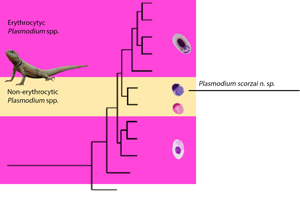Published online by Cambridge University Press: 08 June 2021

Delimiting and describing Plasmodium species in reptiles remains a pressing problem in Haemosporida taxonomy. The few morphological characters used can overlap, and the significance of some life-history traits is not fully understood. Morphologically identical lizard Plasmodium forms have been reported infecting different cell types (red and white blood cells) in the same host and have been considered the same species. An example is Plasmodium tropiduri tropiduri, a species known to infect erythrocytes, thrombocytes and lymphocyte-like cells. Here, both forms of P. t. tropiduri were analysed using light microscope-based morphological characteristics and phylogenetic inferences based on almost complete mitochondrial genomes of parasites naturally infecting lizards in southeastern Brazil. Although morphologically similar, two distinct phylogenetic lineages infecting erythrocytes and non-erythrocytic cells were found. The lineage found in the erythrocytes forms a monophyletic group with species from Colombia. However, the non-erythrocytic lineage shares a recent common ancestor with Plasmodium leucocytica, which infects leucocytes in lizards from the Caribbean islands. Here, Plasmodium ouropretensis n. sp. is described as a species that infects thrombocytes and lymphocyte-like cells.